Related Research Articles

Fire is the rapid oxidation of a material in the exothermic chemical process of combustion, releasing heat, light, and various reaction products. At a certain point in the combustion reaction, called the ignition point, flames are produced. The flame is the visible portion of the fire. Flames consist primarily of carbon dioxide, water vapor, oxygen and nitrogen. If hot enough, the gases may become ionized to produce plasma. Depending on the substances alight, and any impurities outside, the color of the flame and the fire's intensity will be different.

Peat is an accumulation of partially decayed vegetation or organic matter. It is unique to natural areas called peatlands, bogs, mires, moors, or muskegs. Sphagnum moss, also called peat moss, is one of the most common components in peat, although many other plants can contribute. The biological features of sphagnum mosses act to create a habitat aiding peat formation, a phenomenon termed 'habitat manipulation'. Soils consisting primarily of peat are known as histosols. Peat forms in wetland conditions, where flooding or stagnant water obstructs the flow of oxygen from the atmosphere, slowing the rate of decomposition. Peat properties such as organic matter content and saturated hydraulic conductivity can exhibit high spatial heterogeneity.
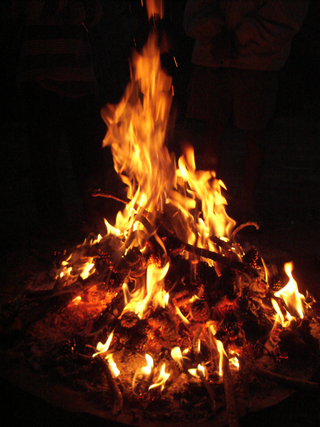
A campfire is a fire at a campsite that provides light and warmth, and heat for cooking. It can also serve as a beacon, and an insect and predator deterrent. Established campgrounds often provide a stone or steel fire ring for safety. Campfires are a popular feature of camping. At summer camps, the word campfire often refers to an event at which there is a fire. Some camps refer to the fire itself as a campfire.
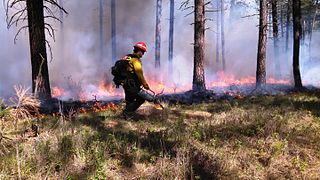
A controlled or prescribed (Rx) burn is the practice of intentionally setting a fire to change the assemblage of vegetation and decaying material in a landscape. The purpose could be for forest management, ecological restoration, land clearing or wildfire fuel management. A controlled burn may also refer to the intentional burning of slash and fuels through burn piles. Controlled burns may also be referred to as hazard reduction burning, backfire, swailing or a burn-off. In industrialized countries, controlled burning regulations and permits are usually overseen by fire control authorities.

Firefighting is a profession aimed at controlling and extinguishing fire. A person who engages in firefighting is known as a firefighter or fireman. Firefighters typically undergo a high degree of technical training. This involves structural firefighting and wildland firefighting. Specialized training includes aircraft firefighting, shipboard firefighting, aerial firefighting, maritime firefighting, and proximity firefighting.

A coal-seam fire is a burning of an outcrop or underground coal seam. Most coal-seam fires exhibit smouldering combustion, particularly underground coal-seam fires, because of limited atmospheric oxygen availability. Coal-seam fire instances on Earth date back several million years. Due to thermal insulation and the avoidance of rain/snow extinguishment by the crust, underground coal-seam fires are the most persistent fires on Earth and can burn for thousands of years, like Burning Mountain in Australia. Coal-seam fires can be ignited by self-heating of low-temperature oxidation, lightning, wildfires and even arson. Coal-seam fires have been slowly shaping the lithosphere and changing atmosphere, but this pace has become faster and more extensive in modern times, triggered by mining.
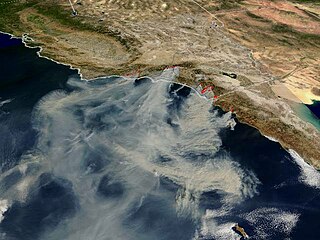
The Cedar Fire was a massive, highly-destructive wildfire, which burned 273,246 acres (1,106 km2) of land in San Diego County, California, during October and November 2003. The fire's rapid growth was driven by the Santa Ana wind, causing the fire to spread at a rate of 3,600 acres (15 km2) per hour. By the time the fire was fully contained on November 4, it had destroyed 2,820 buildings and killed 15 people, including one firefighter. Hotspots continued to burn within the Cedar Fire's perimeter until December 5, 2003, when the fire was fully brought under control.

Fire ecology is a scientific discipline concerned with the effects of fire on natural ecosystems. Many ecosystems, particularly prairie, savanna, chaparral and coniferous forests, have evolved with fire as an essential contributor to habitat vitality and renewal. Many plant species in fire-affected environments use fire to germinate, establish, or to reproduce. Wildfire suppression not only endangers these species, but also the animals that depend upon them.
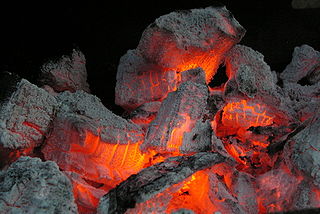
Smouldering or smoldering is the slow, flameless form of combustion, sustained by the heat evolved when oxygen directly attacks the surface of a condensed-phase fuel. Many solid materials can sustain a smouldering reaction, including coal, cellulose, wood, cotton, tobacco, cannabis, peat, plant litter, humus, synthetic foams, charring polymers including polyurethane foam and some types of dust. Common examples of smouldering phenomena are the initiation of residential fires on upholstered furniture by weak heat sources, and the persistent combustion of biomass behind the flaming front of wildfires.
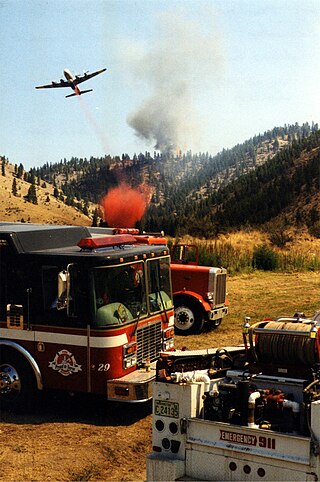
Wildfire suppression is a range of firefighting tactics used to suppress wildfires. Firefighting efforts depend on many factors such as the available fuel, the local atmospheric conditions, the features of the terrain, and the size of the wildfire. Because of this wildfire suppression in wild land areas usually requires different techniques, equipment, and training from the more familiar structure fire fighting found in populated areas. Working in conjunction with specially designed aerial firefighting aircraft, fire engines, tools, firefighting foams, fire retardants, and using various firefighting techniques, wildfire-trained crews work to suppress flames, construct fire lines, and extinguish flames and areas of heat in order to protect resources and natural wilderness. Wildfire suppression also addresses the issues of the wildland–urban interface, where populated areas border with wild land areas.

An ash pit is a remnant of a wildfire. It is a hole in the ground filled with ash, possibly containing hot embers beneath. It is one of the many hazards faced by those fighting wildfires. It is also a danger to residents and their pets returning after a wildfire has gone out.
Wildfire suppression in the United States has had a long and varied history. For most of the 20th century, any form of wildland fire, whether it was naturally caused or otherwise, was quickly suppressed for fear of uncontrollable and destructive conflagrations such as the Peshtigo Fire in 1871 and the Great Fire of 1910. In the 1960s, policies governing wildfire suppression changed due to ecological studies that recognized fire as a natural process necessary for new growth. Today, policies advocating complete fire suppression have been exchanged for those who encourage wildland fire use, or the allowing of fire to act as a tool, such as the case with controlled burns.

The 2010 Russian wildfires were several hundred wildfires that broke out across Russia, primarily in the west in summer 2010. They started burning in late July and lasted until early September 2010. The fires were associated with record-high temperatures, which were attributed to climate change—the summer had been the hottest recorded in Russian history—and drought.

Wildfires are outdoor fires that occur in the wilderness or other vast spaces. Other common names associated with wildfires are brushfire and forest fire. Since wildfires can occur anywhere on the planet, except for Antarctica, they pose a threat to civilizations and wildlife alike. In terms of emergency management, wildfires can be particularly devastating. Given their ability to destroy large areas of entire ecosystems, there must be a contingency plan in effect to be as prepared as possible in case of a wildfire and to be adequately prepared to handle the aftermath of one as well.
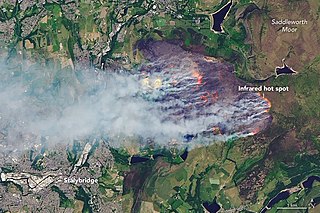
Starting on 24 June 2018 and continuing throughout the summer, a record-breaking series of wildfires burned across the United Kingdom. The two largest fires, which were declared major incidents, burned over 7 square miles each and broke out on Saddleworth Moor in Greater Manchester and Winter Hill in Lancashire. Other large fires broke out in Glenshane Pass in County Londonderry, Northern Ireland, Epping Forest, in London and in the Vale of Rheidol in Ceredigion, Wales. The Saddleworth Moor fire has been described as the largest English wildfire in living memory. Most of the wildfires occurred during the first official heatwave in the United Kingdom since June 2017, with temperatures reaching above 30 °C (86 °F) for several days, making the hottest June in the country since 1995, and the driest June for over ten years in large parts of the United Kingdom, exacerbating the crisis. A wildfire started on the Staffordshire Moorlands on 9 August and, despite rain, had spread to cover 219 acres by 11 August. Some hot spots were still burning as at 22 August. In total, there were 79 fires over the course of the year, a new record. However, the record was beaten in 2019 with 96 fires as of April 23.

The Camp Fire was the deadliest and most destructive wildfire in California's history, and the most expensive natural disaster in the world in 2018 in terms of insured losses.

The LNU Lightning Complex fires were a large complex of wildfires that burned during the 2020 California wildfire season across much of the Wine Country area of Northern California – Lake, Napa, Sonoma, Solano, and Yolo Counties, from August 17 to October 2, 2020. The complex was composed of numerous lightning-sparked fires, most of which were small. While they ignited separately from each other, the Hennessey Fire eventually grew to merge with the Gamble, Green, Markley, Spanish, and Morgan fires, scorching 192,000 acres (777 km2) by itself, for a total burn area of 363,220 acres (1,470 km2) in the complex. The fire, which burned in the hills surrounding several large cities, such as Fairfield, Napa, and Vacaville, destroyed 1,491 structures and damaged a further 232. In all, six people were killed and another five injured. The LNU Lightning Complex is the sixth-largest wildfire in the recorded history of California.

The 2021 Arizona wildfire season was a series of wildfires that burned across the state of Arizona, United States. Wildfires across the state burned 524,428 acres (212,228 ha) of land in at least 1,773 fires throughout the state, fueled in part by a drought, hot temperatures, and thunderstorms producing dry lightning. At one point in late June, over 20 active wildfires were burning across the state.
The White Rock Lake fire was a wildfire in Thompson-Nicola Regional District, British Columbia. It began July 13, 2021 as one of the 2021 B.C. wildfires and resulted in the destruction of Monte Lake. It totalled 83,047 hectares and was classified as out of control. Insured losses total an estimated $77 million Canadian Dollars, according to one agency, which in late September expected the number of claims to top 800, most of them related to residential property.
References
- ↑ Werner, Philip (30 August 2011). "Root Fires and Leave No Trace Campfire Building". sectionhiker.com. Retrieved April 18, 2020.
- ↑ Yan, Holly (May 26, 2016). "How wildfires can return from the dead". cnn.com. Retrieved April 18, 2020.
- ↑ "What Are The Differences Between A Ground Fire And A Surface Fire?". WorldAtlas. 3 October 2018. Retrieved 2020-07-10.
- ↑ "Oregon fires burning underground pose new threat". 22 September 2020. Retrieved 2021-05-16.
- ↑ "These fires are huge, hidden and harmful. What can we do?" . Retrieved 2021-05-16.